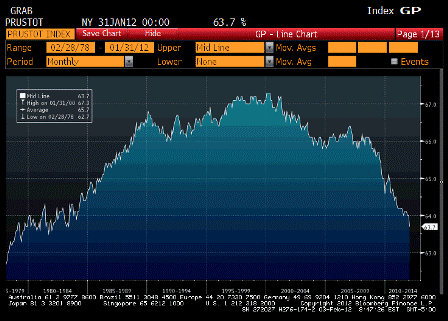Chart of the day: Labor force participation rate at 30-year low
The jobs data were the best we have seen in a long time and well above expectations. This and the first upward revisions to the annual revisions were a pleasant surprise. While a lot of people are in disbelief because of a present bearish bias, you have to take the numbers for what they are and they are bullish. I still feel that the US economy is at stall speed and expect a second recession by the end of 2013 but I am prepared to upgrade my assessment based on how things proceed. That said, this is just one month’s data in a notoriously noisy month for employment data (See the premium post Jobless claims jump may be seasonality).
Here’s the data point everyone is talking about: Labor Force Participation (courtesy of Warren Mosler)
My take on this: A declining labor force participation rate is a bad thing. It says people are dropping out of the labor force. So despite the bullish headline figure, the question still remains as to how robust the jobs market is.
Here are three things to consider:
- Cyclical: that’s the point I made above. Low participation is a negative signal.
- Structural: A lot of people have been pointing to long-term unemployment as a sign that the jobs market is weak. This makes sense and it should put downward pressure on the participation rate as people drop out of the labor force. The difference here is that if the problem is structural and not cyclical, the so-called output gap will continue to be large as throngs of people remain out of the labor force.
- Secular: The first cohorts of boomers started to retire last year. I know many people that were close to retirement when the recession began in 2007 that have had to change plans. Some have delayed retirement because of financial turmoil. But many others have accelerated retirement unwillingly because they were forced out of the labor force. Expect the loss of boomers to put downward pressure on the labor force for years to come.
My guess is that all three factors are affecting the labor force participation rate here. But I am beginning to think that the structural and secular forces are starting to predominate.
One last point, the upward annual revisions are also pretty bullish because it suggests the birth-death model may now be undercounting net new company creation rather than overcounting as it has been for the last few years.
Also see: Here’s The Truth About The Massive, Million Plus Spike In People Not In The Labor Force

Figues dont lie but liars sure can figure.
If the long term unemployed can live off the gub’ment why look? I know a group of recent college graduates in engineering. 50% have found work over the jpast 2 years. I am talking about grads from a top school in the US. Even the few who have jobs are not in egineering fields. Our Presideent wants more engineers but is killing jobs that demand engineers like crazy.
So if you cannot change unemployment….change how you ‘calculate’ unemployment. It is just like the so-called ‘inflation’ number….just take out little expenses like food and energy and anything else that will make the number bad, like animal feed, and there you have it NO INFLATION.
IT IS LIKE MAGIC…..WOW!